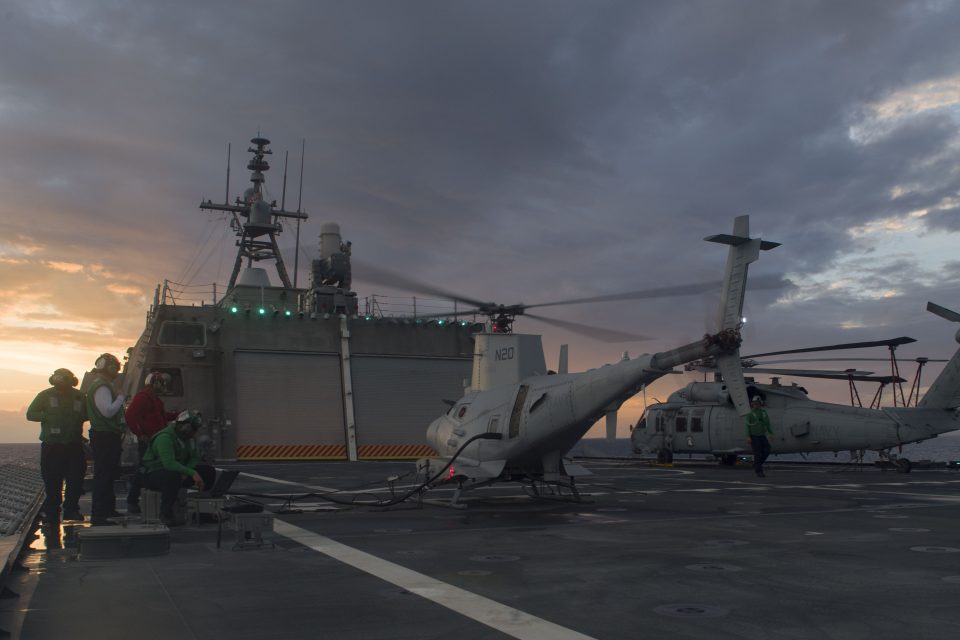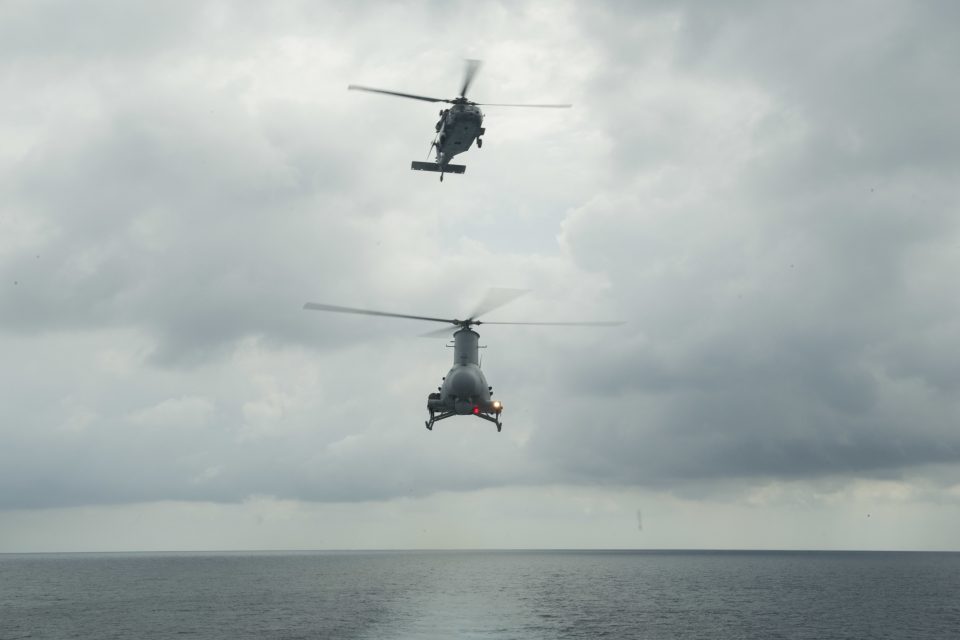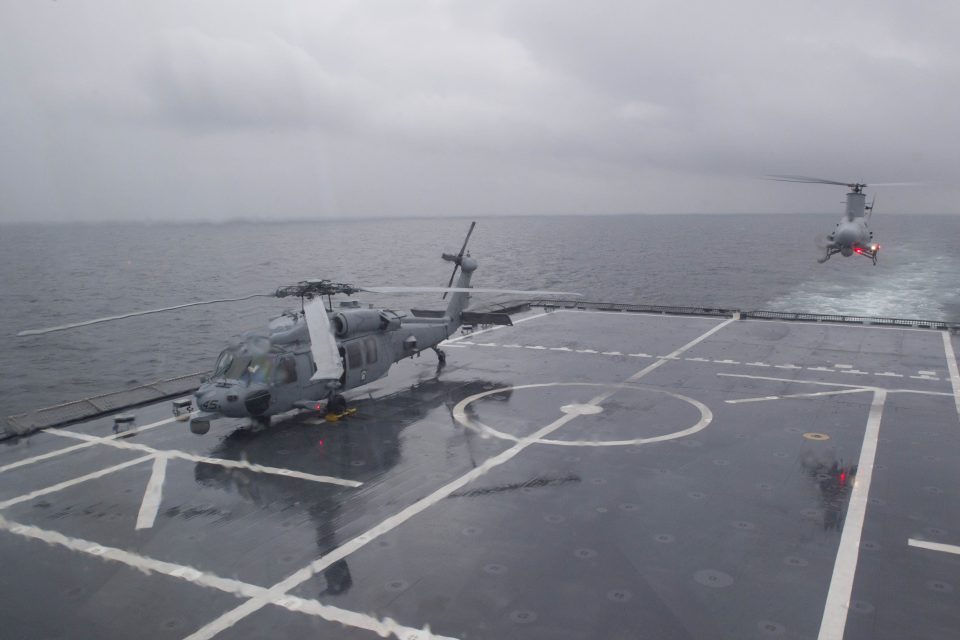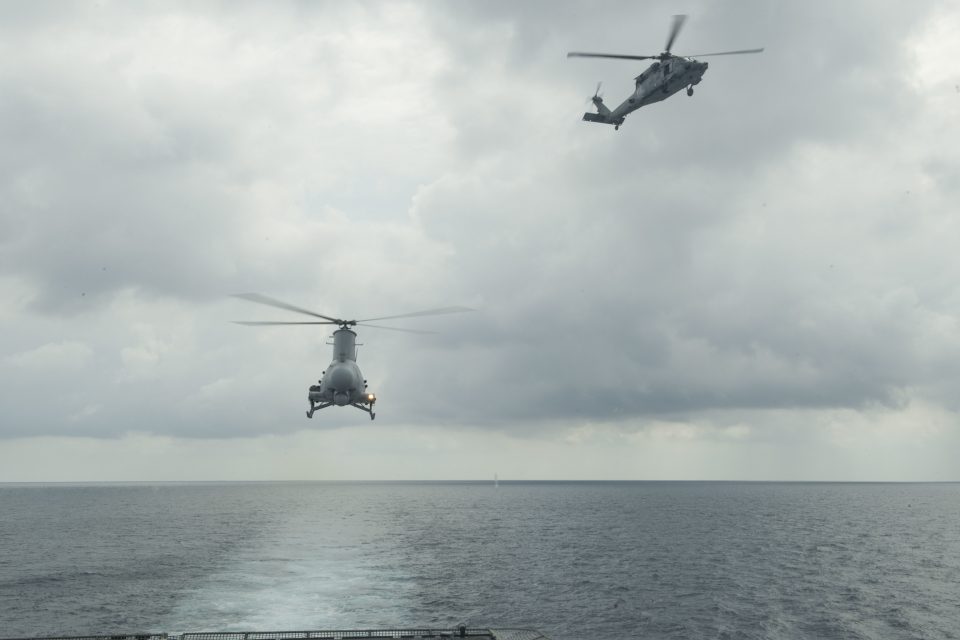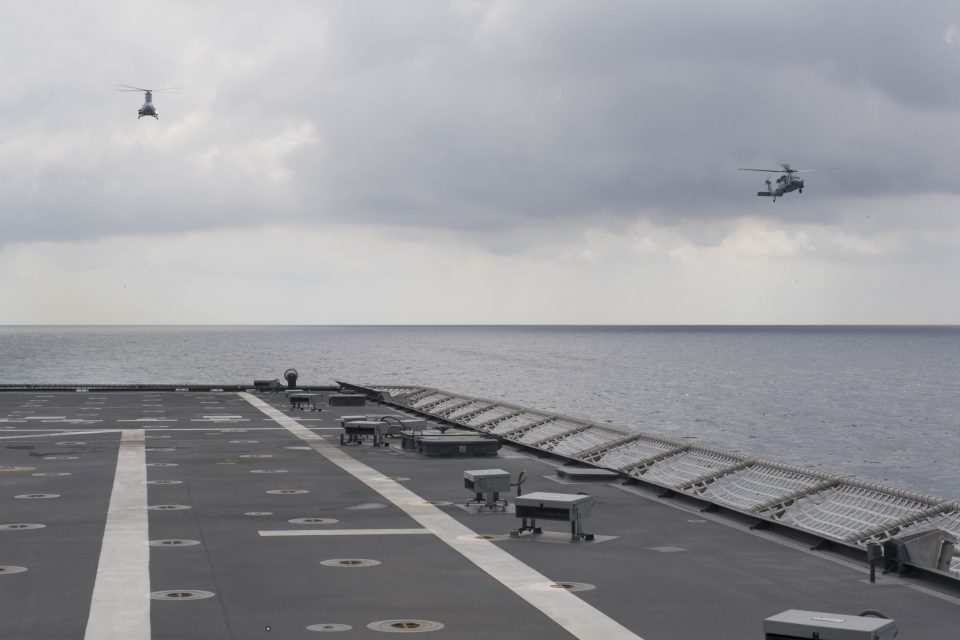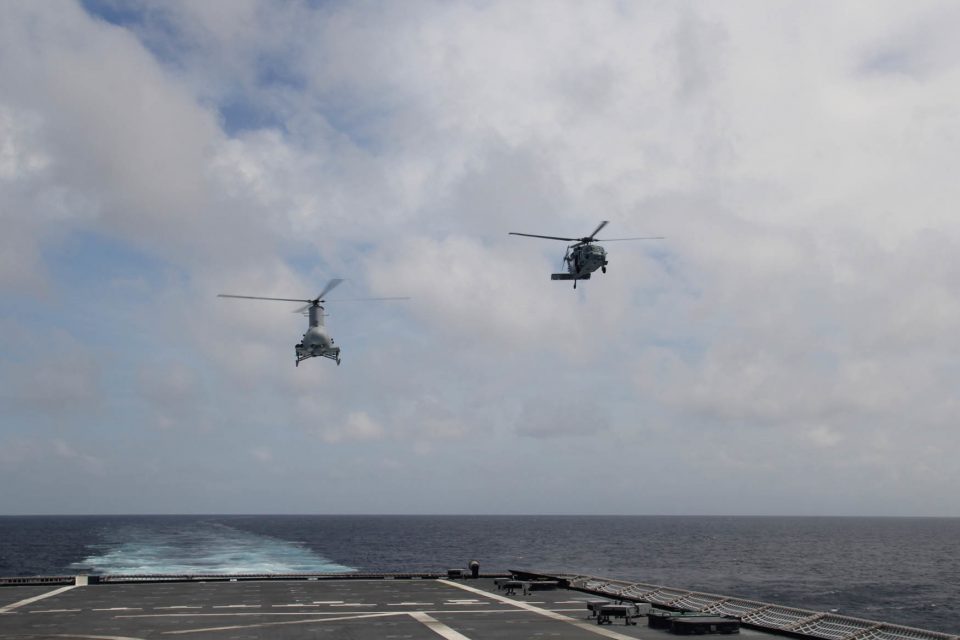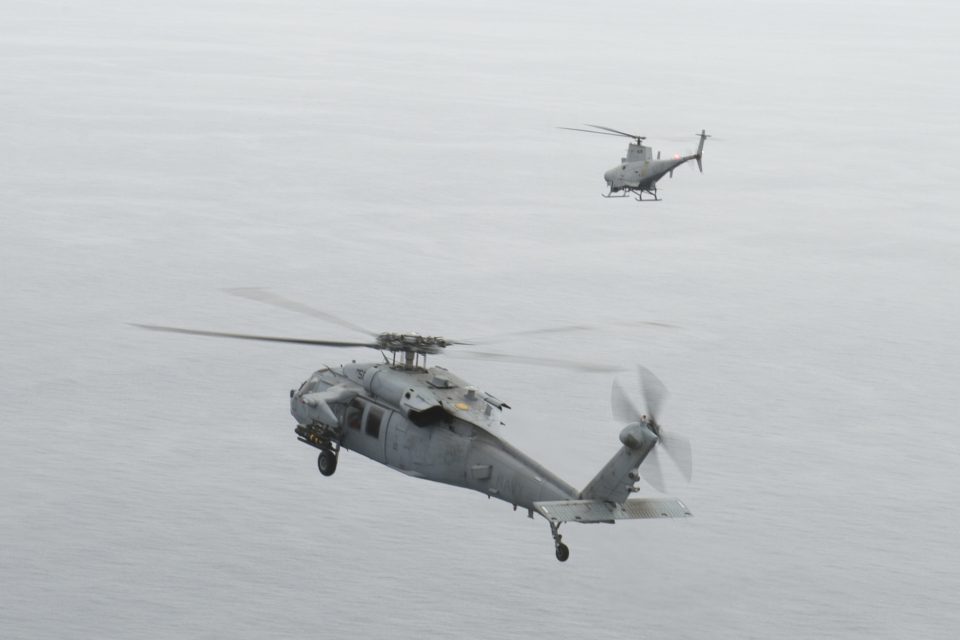2017-07-23 By Robbin Laird
A key element of evolving naval power is the ability to integrate unmanned with manned assets aboard the sea base.
This is not only a work in progress, but a capability which will evolve over time with the technology, the operational experience and the ability to leverage the shift in culture which this integration brings to the fleet.
With the framing of the distributed lethality and kill web concepts, the US Navy and Marine Corps team are focused on distributing and dynamically integrating C2 with ISR with strike capabilities.
The very nature of distributed warfare means that the shift is from looking at a ship simply from the standpoint of what organically is on that ship, to how that ship contributes to the battle fleet by contributing assets to that fleet.
We have looked earlier at two key examples of how the US Navy and Marine Corps are working manned and unmanned integration.
The first is the shaping of a new maritime domain awareness strike enterprise built around synergy between the P-8 and the Triton.
With regard to Triton and P-8, the US Navy will operate them as a dyad. The USN is approaching the P-8/Triton combat partnership, which is the integration of manned, and unmanned systems, or what are now commonly called “remotes”.
The Navy looked at the USAF experience and intentionally decided to not build a Triton “remote” operational combat team that is stovepiped away from their P-8 Squadrons.
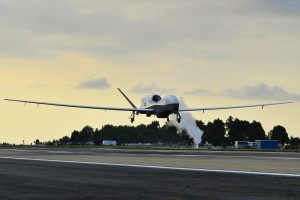 The MQ-4C Triton unmanned aircraft system approaches the runway at Naval Air Station Patuxent River, Md., after completing its inaugural cross-country flight from California. The Navy will conduct Triton flight tests at Patuxent River in preparation for an operational deployment in 2017. (U.S. Navy photo by Kelly Schindler/Released)
The MQ-4C Triton unmanned aircraft system approaches the runway at Naval Air Station Patuxent River, Md., after completing its inaugural cross-country flight from California. The Navy will conduct Triton flight tests at Patuxent River in preparation for an operational deployment in 2017. (U.S. Navy photo by Kelly Schindler/Released)
The teams at Navy Jax and Pax River are building a common Maritime Domain Awareness and Maritime Combat Culture and treats the platforms as partner applications of the evolving combat theory. The partnership is both technology synergistic and also aircrew moving between the Triton and P-8.
The P-8 pilot and mission crews, after deploying with the fleet globally can be assigned significant shore duty flying Tritons. The number of personnel to fly initially the Tritons is more than 500 navy personnel so this is hardly an unmanned aircraft. Hence, inside a technological family of systems there is also an interchangeable family of combat crews.
These new systems are all software upgradeable which sets in motion the opportunity and a need to shape new acquisition approaches to take advantage of software, which can evolve to deal with the threat environment as well.
Software upgradeability provides for a lifetime of combat learning to be reflected in the rewriting of the software code and continually modernizing existing combat systems, while adding new capabilities over the operational life of the aircraft.
Over time, fleet knowledge will allow the US Navy and its partners to understand how best to maintain and support the aircraft while operating the missions effectively in support of global operations.
The second example is being played our right now at sea with the first deployment of the USS America.
The Marines have deployed the Blackjack UAV at sea and are working its integration with manned assets operating within the Amphibious Task Force.
The Blackjack is deployed from a San Antonio class LPD but it launches from that platform but contributes to the entire situational awareness of the task force.
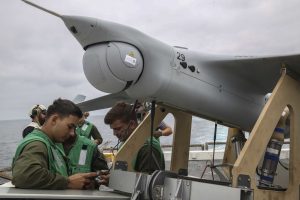 PACIFIC OCEAN – Marines complete final data updates before launching the RQ-21A Blackjack to support surveillance for a visit, board, search and seizure mission conducted by the 15th Marine Expeditionary Unit Maritime Raid Force during Composite Training Unit Exercise, May 12, 2017. The RQ-21A Blackjack enhances and extends the lethal and nonlethal capability of the 15th Marine Expeditionary Unit, fostering transformational advancements in battlespace command and situational awareness. The Marine and aircraft is with Marine Medium Tiltrotor Squadron 161 (REIN) attached to the 15th MEU. (U.S. Marine Corps photo by Cpl. Timothy Valero)
PACIFIC OCEAN – Marines complete final data updates before launching the RQ-21A Blackjack to support surveillance for a visit, board, search and seizure mission conducted by the 15th Marine Expeditionary Unit Maritime Raid Force during Composite Training Unit Exercise, May 12, 2017. The RQ-21A Blackjack enhances and extends the lethal and nonlethal capability of the 15th Marine Expeditionary Unit, fostering transformational advancements in battlespace command and situational awareness. The Marine and aircraft is with Marine Medium Tiltrotor Squadron 161 (REIN) attached to the 15th MEU. (U.S. Marine Corps photo by Cpl. Timothy Valero)
And a third example is the work the US Navy has done onboard the LCS with regard to integrating the Fire Scout UAV with the MH-60S manned system.
The entire approach is to shape an operational experience with the two systems working together and then to build forward from that experience.
Ideally, any future acquisition of new systems would build from this operational experience and inform the evolution of fleet capability.
Although the LCS is currently the only ship in the US Navy set up to support integrated Fire Scout/MH-60S operations, obviously this integration can be applied to current or future fleet assets, such as the new frigate.
And the integration effort, which is a work in progress, is part of the overall effort to distribute ISR, C2 and strike and to offboard sensors and strike elements.
Earlier this year, the dyad worked together for the Fire Scout to provide targeting data to an MH-60S to then launch a Hellfire missile.
In an article by Lieutenant Michael DiDonato HSC-23 Public Affairs published on May 15, 2017, this effort was described as follows:
SAN CLEMENTE ISLAND, Calif. (NNS) — The “Wildcards” of Helicopter Sea Combat Squadron (HSC) 23 made history this month, operating MQ-8B Fire Scout Unmanned Air Vehicles (UAV) from Naval Auxiliary Landing Field (NALF) San Clemente Island utilizing a Mobile Mission Control Station (MMCS).
Teams of pilots, aircrewmen, maintenance personnel and civilian specialists functioned organically to complete integrated missions with various surface and air assets.
The two-week operation culminated with the successful employment of the Fire Scout as the laser designating platform for an AGM-114N Hellfire missile, fired from an MH-60S Knighthawk attached to HSC-23 Detachment 2 on board America-class amphibious assault ship USS America (LHA 6).
Additionally, the team accomplished the first ever long-range transit of the Fire Scout by an operational squadron, executing a “control station handoff” while transiting between NALF San Clemente Island and Naval Base Ventura County (NBVC) Pt. Mugu. This operation has paved the way for the future development of the Fire Scout program, functioning as a force multiplier for the larger naval surface community and the tactical application of integrated manned and unmanned platforms in Naval Aviation.
Personnel from HSC-23 began operations from NALF San Clemente Island on May 3.
Prior to this detachment, Fire Scout operators conducted all flight training at NBVC Pt. Mugu, which is approximately 175 miles northwest of San Diego. Bringing the system to NALF San Clemente Island, which is located 80 miles west of San Diego, afforded many opportunities for integrated training with naval assets due to the multitude of ranges and support facilities around the island. The detachment planned and coordinated events despite an array of logistical hurdles, and established procedures for unmanned air vehicle operations within San Clemente Island airspace.
“A primary goal for this detachment was to showcase the capabilities of the MQ-8B,” said Lt. Cmdr. David Barnhill, officer-in-charge of the detachment. “San Clemente Island broadens the training opportunities for our Fire Scout team and gives us the ability to work with a multitude of assets not otherwise available.”
After completing unit-level training and confidence testing of the Fire Scout system within local and special use airspace during the first week, Fire Scout crewmembers flew range clearance missions and a successful Hellfire missile event in support of USS America Amphibious Ready Group (ARG) on May 10.
“The Hellfire shot was absolutely a highlight for this detachment. It proved that Fire Scout is a viable asset to an already potent team,” continued Barnhill. “But more than that, executing a successful in-flight transfer of the MQ-8B from one air vehicle operator to another over 70 miles away was the biggest milestone. It gives us enormous operational flexibility going forward to work with fleet elements on a regular basis.”
This detachment can be classified as a resounding success by bringing UAV operations to the fleet on a larger scale than ever before. The Fire Scout provides critical mission sets to enhance battlespace awareness as well as providing early warning detection and classification capability. HSC-23 is at the forefront of MQ-8B Fire Scout operations, driving the development and refinement of manned/unmanned tactics and providing a clear path for the future of Fire Scout operators.
HSC-23 “Wildcards” are a Coronado-based expeditionary squadron under Commander, Helicopter Sea Combat Wing Pacific. It is the first squadron to deploy a MH-60S and MQ-8B composite detachment aboard an Independence-class littoral combat ship.
http://www.navy.mil/submit/display.asp?story_id=100454
I had a chance recently to sit down in the Pentagon with Navy officers involved with shaping the composite detachment and thinking through the way ahead in this dynamic and significant area of innovation for the fleet.
The interview was conducted with Lt. Commander Doug Kay, the Fire Scout Assistant Requirements Officer and previously was the air boss on the USS Fort Worth.
The second officer was Commander Ted Johnson, the Fire Scout Requirements Officer and former commander of an MH-60S Seahawk squadron.
And the final officer was Kyle Gantt, a Surface Warfare Officer who works on future ship requirements.
We had a wide-ranging conversation and during that conversation the officers made a number of key points.
First, as one officer put it: “I think one of the benefits of the manned-unmanned teaming concept is you can play to the strengths and weaknesses of each of the two.
“Right now, we’re deploying Fire Scout with MH-60S detachments onboard LCS. Sierra is somewhat sensor deprived.”
The dynamic decision-making is challenging to program into an unmanned platform so the pairing allows the two-man team in the MH-60S to use the data from the Fire Scout to inform their decisions.
“A Fire Scout has much greater persistence than a manned helicopter and allows it to do broad area maritime search with its payloads and to provide queuing for the manned platform.”
The C2 revolution is at the heart of distributed lethality and shaping kill webs.
And the concept of a composite deployment provides support for that revolution.
As one officer put it: “I think it’s all about using the payloads onboard the UAS and being able to efficiently get that information back to the right decision maker whether that right decision maker is in the cockpit of another helicopter, or that decision maker is on the ship.”
Second, the crewing is being shaped to support the manned-unmanned pairing.
Crew needs to be able to maintain, support and to operate two different systems and to do so within the confines of a small ship, the LCS.
This puts a premium on shaping crew skill sets which can synergistically support the composite detachment.
As one officer put it: “When aviators break the aircraft, they fix them, both the manned and the unmanned.
“All the operators, both the crewmen and the pilots are cross-trained to operate both types of aircraft. We have dual qualified operators.”
And the advantage of doing so provided a better understanding of what the dyad could deliver as an overall capability.
“What we have found is that you create a more cohesive team when the MQ-8 operators also know how to fly the 60, and the 60 operators know how to fly the MQ-8, and have changed those roles several times during the week.
“Basically, they then understand the limitations and abilities of each system and the synergy which can be achieved by operating together.”
In effect, what the Navy is creating is a common operational culture shaped by the two systems, rather than creating an unmanned operational ghetto.
Third, the actual operational experience of working a composite detachment will drive future operations and future operational requirements.
It is an iterative process.
Clearly, the US Navy is acting on the assumption that one needs to get the technology into the hands of the warfighter to drive innovation rather than building better briefing charts.
After all, power point slides only kill the audience, not the enemy.
Fourth, the operational experience of the dyad will be part of shaping the way ahead with ship design, and requirements as well.
As one officer put it: “As we look at what ships we need and how to use them in the future, this concept of manned-unmanned teaming both with organic systems as well as the use of national systems use is really critical to how we will use those ships, and how we’ll deliver those capabilities.”
In simple terms, it is about getting best value out of systems, which operate from the deck space.
As one officer put it: “Everything that goes on the ship has to buy its way on the ship through the capability that it delivers.”
In short, the composite detachment is viewed as a cutting edge capability which will be enhanced in the future.
“The future of aviation certainly offers the distributed fleet a suite of capabilities that are met between a pairing of manned and unmanned systems.
“What missions will go to the manned and unmanned, well that remains to be seen, but most definitely the future of aviation is going to be a pairing of both manned systems and unmanned systems.”
Editor’s Note: The slideshow highlights the composite detachment and the photos are credited to the US Navy.



